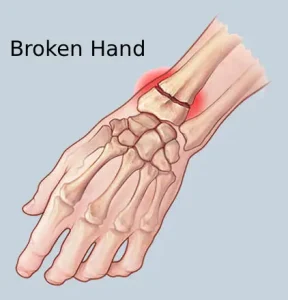Overview
A broken hand refers to a fracture in one or more of the bones of the hand, including the fingers, metacarpals, or small wrist-adjacent bones. Hand fractures are common injuries that can affect daily activities such as gripping, writing, and lifting. The severity of a broken hand can range from minor cracks to complex fractures involving joints. Early diagnosis and proper treatment are important to restore hand strength, movement, and function.
Symptoms
Symptoms of a broken hand may vary depending on which bone is affected and how severe the fracture is. Common symptoms include:
-
Pain that increases with movement or pressure
-
Swelling, bruising, or tenderness in the hand or fingers
-
Difficulty gripping objects or making a fist
-
Visible deformity, such as a crooked finger or knuckle
-
Stiffness or limited range of motion
In some cases, numbness or tingling may occur if nerves are involved.
Causes
A broken hand is usually caused by direct trauma or force. Common causes include:
-
Falls onto an outstretched hand
-
Sports injuries, especially in contact sports
-
Punching hard objects or accidental impacts
-
Workplace or household accidents
-
Motor vehicle accidents
Risk factors
Several factors can increase the risk of a broken hand:
-
Participation in high-risk or contact sports
-
Lack of protective equipment during activities
-
Osteoporosis or other conditions that weaken bones
-
Poor hand protection during manual work
-
Previous hand injuries
Complications
Most broken hands heal well with appropriate care, but complications can occur, especially with severe or untreated fractures:
-
Delayed healing or improper bone alignment
-
Reduced grip strength or hand function
-
Joint stiffness or loss of flexibility
-
Nerve or tendon damage
-
Chronic pain or deformity
Prevention
While not all hand fractures can be prevented, certain measures can reduce the risk:
-
Wearing protective gloves during sports or manual work
-
Using proper techniques and safety equipment during activities
-
Maintaining bone strength through balanced nutrition and exercise
-
Avoiding punching hard surfaces or objects
-
Taking precautions to prevent falls and accidents
Prompt medical assessment after a hand injury can help ensure proper healing and reduce the risk of long-term problems.
Advertisement

